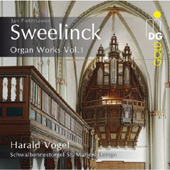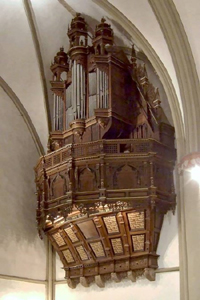
ESSENTIAL RECORDINGS


1- Toccata No. 1 in D minor, SwWV 285
2- Echo Fantasia for organ in D minor, SwWV 261
3- Psalm 116
4- Ik heb den Heer lief (Psalm 116), variations for organ, SwWV 313
5- Fantasia for organ in A minor, SwWV 273
6- Toccata for keyboard No. 3 in A minor, SwWV 298
7- Erbarm dich mein, o Herre Gott, chorale variations for organ, SwWV 303
8- Ave maris stella, canon for 3 voices, SwWV 193
9- Capriccio, SwWV 281
10-Allemande, SwWV 330
11-Toccata No. 4 in G minor, SwWV 295
12-Various registration demonstrations
It is sometimes surprising to realize that organ music so strongly associated with the German Baroque, actually originated from many dissimilar sources, and eventually
attained its highest form after undergoing many varied transformations. The English influence of Byrd and Bull from the west, the Italian influence of Frescobaldi and
Gabrieli from the south, the Dutch influence of Jan Pieterszoon Sweelinck (1562-1621) from the north, all played a part in shaping what was to become one of the
highest forms of musical culture. Sweelinck was one of many to visit Italy and return with a plethora of new ideas to inject into his own creations, and to pass down to his
students. He was the product of Italy but his pupils were German. He had so many of these pupils that writers described him as "the maker of German organists."
His influence was handed down from student to student, from Scheidemann to Reinken, to Buxtehude and to Johann Sebastian Bach. Although his music is harmonically
na´ve and whose predominant form was based on variation rather than development, it formed the bridge that led to the rapid growth of counterpoint, the fugue, and
harmonic discoveries that flourished under the hands of Bach.
Organist Harald Vogel, whose previous recordings on MDG Records of the complete organ works of Buxtehude have been the
recipients of many prestigious awards, begins his traversal of the organ music of Sweelinck with the same scholarly and meticulous approach. It is obvious from his
judicious use of stops, that research was done as to which registers were available to Sweelinck himself on his organ in the Oude Kerk in Amsterdam. And unlike many
organists who, due to the repetitive nature of some of the canonic variations or the linear harmonic flow, give the music a protracted or mechanical feel, Harald Vogel
manipulates and shapes each musical phrase just enough to bring out the music's hidden character.
The swallow's nest organ in the church of St Marien in Lemgo is the only one of its kind in Germany which predates the Thirty Year's War, which is outwardly
in good condition and which still stands where it was built. With its reconstruction, the organ builder Rowan West and the organ expert Koos van de Linde have succeeded
in forward-looking work, through which a lost world of sound again becomes an integral part of the global organ culture and which serves as a model for emulation. The
Renaissance organ in St Marien in Lemgo is an instrument of European significance. {Harald Vogel}
With its clear tones and sharp Mixtur and Nasatt stops, this instrument is perfectly suited to the music of Sweelinck. The booklet notes list the registration for each and
every piece in detail, as well as informative background notes on the composer and the organ. As an added bonus, the organist himself presents a detailed tour of
the organ's registers, and their relationship to each other, in the form of short improvisations. And of course, everything is presented in natural acoustics and pristine
sound quality.
Jean-Yves Duperron - August 2011